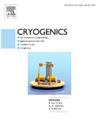Qualification of a 90 K high-capacity cryocooler for cryo fluid management
IF 2.1
3区 工程技术
Q3 PHYSICS, APPLIED
引用次数: 0
Abstract
Creare recently completed integration, qualification testing, and delivery of a high-capacity turbo-Brayton cooler designed to meet NASA’s needs for long-duration storage of liquid oxygen and methane in space. High capacity is defined as providing over 100 W of refrigeration at 90 K for the purposes of this paper. Zero-boil-off storage of these propellants is a key enabling technology for several NASA missions. Due to the size of the propellant tanks, an active refrigerator is required to intercept the heat loads, maintaining the cryogen temperature and eliminating boil-off. This cryocooler is a scaled-up version of the 20 W, 90 K cryocooler that Creare delivered to NASA in 2012 which was used in NASA’s initial ground demonstrations of reduced boil-off hydrogen storage and zero-boil-off oxygen storage. The cryocooler was integrated in a flight prototypical arrangement suitable for thermal performance and launch vibration testing and to support planned ground-based zero-boil-off demonstrations at NASA. The demonstrated refrigeration capacity is over 120 W of refrigeration at 90 K and over 200 W at 118 K, supporting a broad range of storage pressures for both liquid oxygen and liquid methane respectively. Launch vibration testing was also successfully completed on the integrated unit. This paper reviews the qualification test results for the cryocooler and presents specific power and specific mass estimates for a flight version of the cooler.
用于冷冻流体管理的90k高容量制冷机的鉴定
Creare公司最近完成了高容量涡轮-布雷顿冷却器的集成、鉴定测试和交付,该冷却器旨在满足NASA在太空中长期储存液氧和甲烷的需求。在本文中,高容量被定义为在90k下提供超过100w的制冷。这些推进剂的零蒸发储存是NASA几个任务的关键实现技术。由于推进剂储罐的大小,需要一个主动制冷机来拦截热负荷,保持冷冻剂温度并消除沸腾。该制冷机是Creare在2012年交付给NASA的20w, 90k制冷机的放大版,该制冷机用于NASA最初的减少蒸发氢储存和零蒸发氧储存的地面演示。制冷机被集成在一个飞行原型中,适合热性能和发射振动测试,并支持NASA计划的地面零蒸发演示。演示的制冷量在90 K时超过120 W,在118 K时超过200 W,分别支持液氧和液态甲烷的广泛储存压力。在集成单元上也成功完成了发射振动测试。本文回顾了该制冷机的鉴定试验结果,并给出了该制冷机飞行版本的比功率和比质量估计。
本文章由计算机程序翻译,如有差异,请以英文原文为准。
求助全文
约1分钟内获得全文
求助全文
来源期刊

Cryogenics
物理-热力学
CiteScore
3.80
自引率
9.50%
发文量
0
审稿时长
2.1 months
期刊介绍:
Cryogenics is the world''s leading journal focusing on all aspects of cryoengineering and cryogenics. Papers published in Cryogenics cover a wide variety of subjects in low temperature engineering and research. Among the areas covered are:
- Applications of superconductivity: magnets, electronics, devices
- Superconductors and their properties
- Properties of materials: metals, alloys, composites, polymers, insulations
- New applications of cryogenic technology to processes, devices, machinery
- Refrigeration and liquefaction technology
- Thermodynamics
- Fluid properties and fluid mechanics
- Heat transfer
- Thermometry and measurement science
- Cryogenics in medicine
- Cryoelectronics
 求助内容:
求助内容: 应助结果提醒方式:
应助结果提醒方式:


